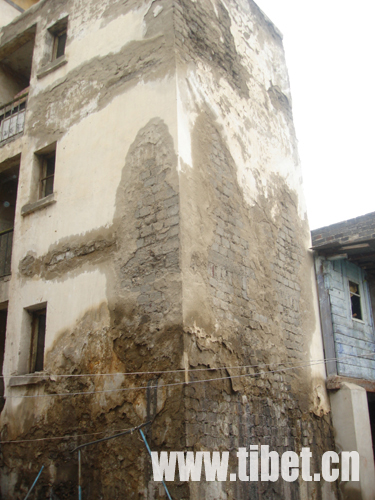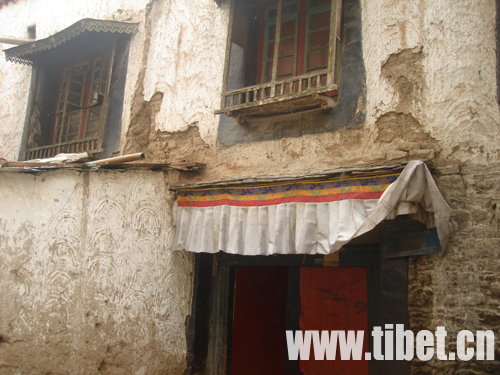
Shi Wenjiang, former head with Lhasa Land & Resource Layout Bureau. (File photo)
Editor's notes: The Barkor Street deserves a historical name card of Lhasa just as a saying goes "The Barkor Street comes into existence before the Lhasa city itself". Ever since the reform and opening-up policy in China, Tibet local governments have been continually granting huge investments to repair the Barkor Street on the premise that the overall feature must remain the same. With years passing by, over the last 30 years, the street has undergone a striking change in many aspects without changing the original culture distillation.
Currently, journalists from China Tibet Information Center had an interview with Shi Wenjiang, who was responsible for the layout as head of Lhasa Land & Resource Layout Bureau at that time. As one of the participants as well as eyewitness, he, current director of Lhasa Newu New Village, detailed the reconstruction of the Barkor Street and the city layout of Lhasa with what he had seen, heard and done.
I、Barkor Street before Reconstruction & Reasons of Renovation
"The masses were clamoring for an improvement of living environment while the government has a strong desire for solution," said Shi Wenjiang.
In the past, either visitors from home and abroad, or local dwellers of different ethnic minorities, agreed that the Barkor Street was a "dirty", "disordered" and "odoriferous" place, where drainage, power supply, communication systems were poor.
Local dwellers were screaming for an effective action to improve their poor living environment, and such was also the government's concern. It is not wise for Lhasa government to let the dissatisfactory environment go on as the Barkor Street is such a place with many roles in one- the "brand card" of Lhasa, the representative of ancient Lhasa city and a place with a long history.
Given that, the local governments of Tibet made up a strong mind to renovate the ancient street. Ever since the early 1990s, the mid-term of 1990s in particular, Tibet has been launching a series of projects to repair buildings which were built after the 60s and 70s in the Barkor Street. Frankly, it was not an easy task for the government to do so since the annual revenue of Lhasa at that time was added up to no more than 30 million yuan. The renovation of Barkor Street is not only a drive to protect historical relics, but to offer a better living environment for locals around or in the Barkor Street. For the whole country, it is a systematical renovation of historical and cultural street while for the government it requires a careful work both from historical and cultural aspects. Meanwhile, it is also an urgent problem to be solved for the local people.

The wall of building in the Barkor Street is spoilt by track of sewage drops.

Ancient protective building before renovation.
II、Meaning & Suggestion of Renovation
"The total protective coverage of Barkor Street is 13,000 square kilometers. We insist one point that ‘renew while origin remains'"
The Barkor Street, centralized by the Jokhang Temple and Ramoche Monastery, carries a history of more than 1,300 years. The Jokang Temple was built after the Princess Wencheng arrived in Tibet. It is not only a historical testimony for the united relationship between Han and Tibetan people, but a masterpiece of cultural and architectural significances. For most of the Buddhists it is even regarded as a landmark of Tibetan Buddhism. Hence, the repair is of great importance to both the country and its people.
The renovation of Barkor Street borrows some successful experience from foreign countries and is carefully done according to the principle that "renew while origin remains". The renovation covers 13,000 square kilometers and accords with the following three methods: repair for cultural relics which under the state level protection should abide by the practice of cultural relics protection; to leave buildings around the Barkor Street and Jokhang Temple just as it was before; modernizing the inner layout is allowed if the outer feature remains the same.
With decade's efforts, the Barkor Street has undergone a striking change comparing with before. The central government has been allocating several hundred million yuan to meliorate the municipal facilities, including highways, power supply, communication systems and so on.
The success of renovation of Barkor Street is commonly recognized by both domestic and foreign experts despite there are still something deficient.

The clean and orderly Barkor Street after renovating.

The overall feature of ancient Tibetan architectures remains the same even after repairing.
III、Protection & City Layout of Lhasa
"The Barkor Street is the continuation of history as well as elements to improve the city's value and it is just our duty to avoid the depreciation when making out the city layout," said Shi Wenjiang.
We have to deal with two knotty problems in our work: to better protect the historical ancient city and to carry out the modernization construction. The two respects are mutually dependent and harmonious rather than incompatible. In my opinion, the emerging of a new city depends on the culture, history and city value of the old one.
We have confidence to protect the ancient city while building a new one under the leadership of the Communist Party of China. Investment which goes for Tibet from the central government is increasing yearly and the public's consciousness of environmental protection is also enhanced.
The Barkor Street, Potala Palace and Norbu Lingka form the main frame of Lhasa. Objectively speaking, the total coverage of downtown Lhasa before the peaceful liberation of Tibet, was not more than 3 square kilometers with a population ranging from 26,000 to 30,000. But now, the cultural protective area of Lhasa is several times larger than the total coverage of downtown Lhasa. Hence, it is easy to know whether Lhasa receives protection or being destroyed.
Speaking of the great changes of Barkor Street over the last decade, I thought, in an objective way, it not only shows the development of the ancient city, but indicates the civilization and progress of Lhasa.
(1 U.S. dollar equals about 6.83 yuan)

Lhasa's yesterday and today.

A distant view of the Potala Palace in the Jokhang Temple. (File photo)
